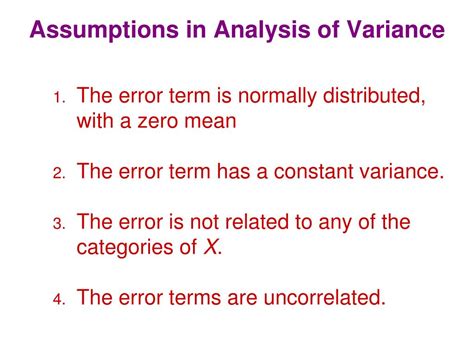Assumptions For Analysis Of Variance

When conducting an Analysis of Variance (ANOVA), several assumptions must be met to ensure the validity and reliability of the results. ANOVA is a statistical technique used to compare means of three or more samples to determine if there is a significant difference between them. The assumptions for ANOVA are crucial because if they are not met, the results of the analysis may be misleading or incorrect.
1. Normality of Residuals
One of the primary assumptions of ANOVA is that the residuals (the differences between the observed values and the predicted values) are normally distributed. This assumption can be checked using plots such as Q-Q plots or through statistical tests like the Shapiro-Wilk test. Normality of residuals is important because ANOVA is based on the F-distribution, which assumes normality. If the residuals are not normally distributed, transformations of the data or alternative analyses like non-parametric tests may be necessary.
2. Homogeneity of Variance
Another critical assumption is the homogeneity of variance, which means that the variance of the residuals should be constant across all levels of the independent variable. This assumption is often referred to as homoscedasticity. Violations of this assumption can lead to incorrect conclusions about the significance of the differences between group means. The F-test is sensitive to violations of this assumption, especially when sample sizes are unequal. Levene’s test or the Brown-Forsythe test can be used to check for homogeneity of variance.
3. Independence of Observations
ANOVA also assumes that the observations are independent of each other. This means that the data points should not be paired or matched in any way that could introduce dependence. For example, if data are collected from the same subjects under different conditions, or if there are clusters within the data (like classrooms within schools), independence might be violated. In such cases, alternative analyses like repeated measures ANOVA or mixed-effects models might be more appropriate.
4. No Significant Outliers
While not always listed as a formal assumption, the presence of significant outliers can affect the results of ANOVA, particularly if the sample size is small. Outliers can influence the mean and variance of the sample, potentially leading to Type I or Type II errors. Identifying and addressing outliers, possibly through data transformation or the use of robust statistical methods, is an important step in ensuring the integrity of the analysis.
5. Random Sampling
Finally, ANOVA assumes that the samples are randomly selected from the population. Random sampling ensures that the samples are representative of the population and helps to avoid biases that could affect the generalizability of the findings.
Addressing Assumption Violations
If the assumptions of ANOVA are violated, there are several strategies that can be employed: - Data Transformation: Applying transformations (e.g., logarithmic, square root) to the data can help achieve normality and homogeneity of variance. - Non-Parametric Tests: Using non-parametric alternatives to ANOVA, such as the Kruskal-Wallis H-test, which do not assume normality of the data. - Robust Statistical Methods: Employing methods that are less sensitive to assumption violations, such as the Brown-Forsythe test or Welch’s t-test for comparing two groups. - Mixed-Effects Models: For data with a complex structure (e.g., nested or clustered data), using mixed-effects models can account for the dependencies in the data.
Understanding and addressing these assumptions are crucial for the valid application of ANOVA and for drawing meaningful conclusions from the data.
What are the primary assumptions of Analysis of Variance (ANOVA)?
+The primary assumptions of ANOVA include normality of residuals, homogeneity of variance, independence of observations, and the absence of significant outliers. Also, the data should be randomly sampled from the population.
How do you check for the normality of residuals in ANOVA?
+Normality of residuals can be checked using Q-Q plots or statistical tests like the Shapiro-Wilk test.
What happens if the assumptions of ANOVA are violated?
+If the assumptions of ANOVA are violated, it can lead to incorrect conclusions. Strategies to address violations include data transformation, using non-parametric tests, employing robust statistical methods, or using mixed-effects models for complex data structures.
In conclusion, understanding the assumptions of ANOVA and ensuring they are met is critical for the accurate interpretation of results. Violations of these assumptions can lead to misleading conclusions, but fortunately, there are strategies and alternative methods available to address such issues, enhancing the validity and reliability of the analysis.